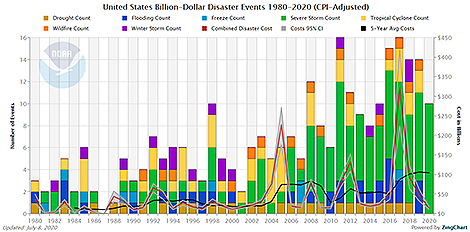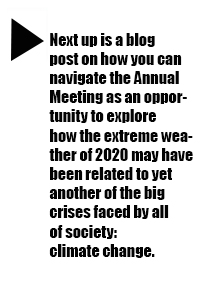We’re on the verge of the first ever all-virtual AMS Annual Meeting—yet another milestone in a time of milestones, but nonetheless our 101st Annual Meeting. And like all of the mega-gatherings AMS has held for the weather, water, and climate community in the past, this coming week (starting Sunday, January 10th), promises many opportunities to catch up with what colleagues have been doing over the past year, what they’re thinking about now, and what they’re planning for coming years.
up with what colleagues have been doing over the past year, what they’re thinking about now, and what they’re planning for coming years.
Although we’ll miss the chance encounters, side conversations, and in-person meet-ups, this year’s virtual format offers a lot of interaction with its breakout rooms and ample time set aside both for concentrated contemplation of presentations and for back-and-forth between presenters and audiences. Indeed, the fact that thousands of people are not all in one place attending parallel tracks of conferences and symposia with walls in-between them means that it may even be easier than ever to hop between sessions without running from room to room.
This Year’s Overarching Theme
The virtual experience may create an opportunity to take in multiple perspectives on the 101st Annual Meeting theme: this AMS tradition of organizing all the parallel conferences together on one unifying theme can come alive with the new format if you’re willing to navigate your own pathway through the presentations with that in mind. This year’s theme is “Strengthening engagement with communities through our science and service.” While on the face of it that theme has the spirit of many Annual Meeting themes of the past, in this meeting those words have more direct relevance on the programming than you may think. We’ll show you how with an upcoming blog post.
In fact, this year’s theme is pivotal for a meeting at this moment. It turned out to anticipate central issues of the year we had in 2020 and the directions and solutions your colleagues are proposing in their presentations, in response to the unique experience of 2020. In an forthcoming post, we’ll lay out these thematic implications by proposing a simple crosscutting pathway through the week’s video presentations, touching on the meeting theme by hopping from symposium to symposium, taking advantage of the Annual Meeting as a virtual experience.
The usual way most of us approach the meeting, of course, is to focus on an area of specialization. That’s why it is organized as always as a collection of about 40 specific conferences and symposia running in parallel—for example the 35th Conference on Hydrology, the 30th Conference on Education, and the 23rd Conference on Atmospheric Chemistry.
But you can imagine many independent, personalized ways to navigate any AMS Annual Meeting, such as a focus on multidisciplinary work, or on award winners’ presentations. In the following blog posts, we’ll dream up a few such tracks for you to take next week.
A Closer Look
Most years, attendees look forward to the AMS Annual Meeting as a chance to catch up on what colleagues have been accomplishing. In 2020, as in any normal year, it’s the major weather events of the past year that shape the work this community does. So as our first example of a pathway through the virtual meeting—think of it as a personalized symposium—we’ll focus on how the Annual Meeting is an opportunity to reflect collectively on 2020 weather and the lessons learned from studying it and forecasting it, and helping the world respond to it. As in the past, the Annual Meeting next week offers a targeted discussion of the past year’s weather, in particular in a symposium on Major Weather Events and Impacts of 2020. These sessions are on Friday, January 15. Among the events covered will be the August Midwest Derecho, high-impact atmospheric rivers, a North Dakota blizzard, the hyperactive 2020 hurricane season, wildfires, atmospheric effects of COVID, and all the 10 separate billion-dollar weather disasters (tying a record number) of the year in the United States (as charted here in historical context from Adam Smith’s abstract).

Given the profusion of major disasters, all the papers about the year are not contained in one set of sessions or one conference. You can make 2020’s weather a multi-conference track through the meeting, if you’re so inclined. 2020 was that kind of year, of course! For example …
- in among the posters for the mesoscale symposium: Samuel Childs (NCAR) and Russ Schumacher (Colorado State) are presenting detailed observations of a severe macroburst on 9 June 2020 in Akron Colorado. The high-resolution in situ data show features like gravity waves in the outflow.
- Also in the mesoscale symposium posters is an evaluation of the difficulty to forecast the August Midwest derecho, by Bruno Z. Ribeiro (SUNY Albany), Steven J. Weiss (SPC), and Lance Bosart (SUNY Albany). They write in their abstract: “This case demonstrates that improvements in the predictability of warm-season derecho-producing MCSs requires better understanding of the evolution from disorganized convection into a linear MCS.”
- In the 21st Symposium on Meteorological Observation and Instrumentation, Melissa Wagner (CIMMS) et al. relate satellite- and unmanned aerial system-based imaging and analysis of the damage path of the devastating Midwest derecho, with the additional benefit of “improving our understanding of how storm-scale radar signatures relate to wind damage.”
- Jordan Schnell (CIRES), Ravan Ahmaov (NOAA/ESRL), and colleagues will be discussing the difficulties operational air quality modelers had in forecasting the impacts of wildfires amid COVID reduced economic activity. According to their abstract: “We will present simulations conducted for August 2020–a period of widespread extreme heat and wildfires–and demonstrate the sensitivities of modeled PM2.5 and O3 to the fire, anthropogenic, and biogenic emission sources.” This is in the Atmospheric Chemistry Conference along with other papers on air quality impacts in 2020.
With wildfires, extreme heat, air quality…this presentation has the overwhelming feeling of simultaneous extreme events of 2020 wrapped up in a nutshell. Indeed, as the above NOAA graphic of billion-dollar disasters exemplifies, the experience of 2020 opened up as never before in the United States a public discourse about the relationship between climate change and vulnerability to extreme weather. Not surprisingly, the AMS Annual Meeting is going to offer many insights on this relationship. That’s yet another thread you can follow as from symposium to symposium you try to personalize the virtual experience of the meeting, We’ll propose that pathway in a follow-on blog post, and right after that we’ll trace several other cross-cutting themes in the Annual Meeting—themes you’d never have found so pervasive in any other years. The 2021 Annual Meeting is unique for the reasons that 2020 was unique.
More Cross-cutting Theme Tie-ins
Of course you’ll note the massive disruption of COVID as mentioned in Ahmaov’s presentation. The pandemic had more impacts than just on air quality, but we explore in a follow-on blog post how the pervasive theme of COVID is in itself a viable personalized crosscutting pathway through the 2021 Annual Meeting, as are some of the other salient societal themes of 2020—the fight against racism, the struggle for social justice and equity, and the response of the sciences to such larger societal issues by seeking better community engagement—thereby making this year’s overarching meeting theme exceptionally timely. These pathways in the Annual Meeting trace the ways the tumultuous year 2020 has left an indelible mark on the weather, water, and climate community, as it did on all other people and professions and sciences.
such larger societal issues by seeking better community engagement—thereby making this year’s overarching meeting theme exceptionally timely. These pathways in the Annual Meeting trace the ways the tumultuous year 2020 has left an indelible mark on the weather, water, and climate community, as it did on all other people and professions and sciences.